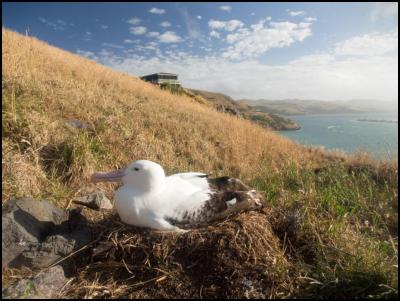Nest cam introduces albatross chick to the world
Nest cam introduces albatross chick to the world

People can now watch online a Northern royal albatross growing up at Pukekura/Taiaroa Head.
The Department of Conservation (DOC) has set up a web cam beside an albatross nest at the albatross colony at Taiaroa Head on Otago Peninsula near Dunedin. DOC worked with the Otago Peninsula Trust, Pukekura Co-management Trust, Wellington City Council and Dunedin City Council to install the web cam.
The chick in the nest hatched five days ago and is being filmed 24 hours a day. DOC’s threatened species ambassador Nicola Toki launched the “royal cam” which went live today.
Nicola said this is the first time a web cam has been used online to view an albatross at the colony. Taiaroa is the world’s only mainland royal albatross breeding colony.
“We are thrilled to share the life history of these awesome seabirds with the rest of New Zealand and the world. Few people in the world have the chance to get this close to a nesting albatross chick. It’s amazing to look right into the nest to see the chick’s new beginning. We are grateful to our supporters for helping make this happen,” Nicola said.
The parents take turns guarding and feeding the chick for the next five or six weeks. They then leave it unguarded, except for feeding visits, until it fledges (is ready to fly) at about eight months. The sex of the chick is unknown at this stage.
The web cam will film the chick over the next eight months. Highlights will include the part both parents play in raising the chick, DOC rangers monitoring and caring for the chick, and challenges it is likely to face. These may include extremes of weather, vulnerability to pests and reliance on its parents to provide enough food to sustain it throughout winter. In spring, the chick will leave Taiaroa Head to spend 4-10 years circumnavigating the southern hemisphere.
You can watch the albatross chick on www.doc.govt.nz/royalcam
ends


 Gordon Campbell: On bird flu, AUKUS entry fees and Cindy Lee
Gordon Campbell: On bird flu, AUKUS entry fees and Cindy Lee NZ Government: New Lab To Help Protect Key Pacific Tuna Fisheries
NZ Government: New Lab To Help Protect Key Pacific Tuna Fisheries Susan Botting - Local Democracy Reporter: Ruawai Leader Slams Kaipara Council In Battle Over $400k Property
Susan Botting - Local Democracy Reporter: Ruawai Leader Slams Kaipara Council In Battle Over $400k Property Te Pati Maori: Another ‘Stolen Generation’ Enabled By Court Ruling On Waitangi Tribunal Summons
Te Pati Maori: Another ‘Stolen Generation’ Enabled By Court Ruling On Waitangi Tribunal Summons Peace Action Wellington: Die In for Palestine Marks ANZAC day
Peace Action Wellington: Die In for Palestine Marks ANZAC day Labour Party: Penny Drops – But What About Seymour And Peters?
Labour Party: Penny Drops – But What About Seymour And Peters? Government: PM Announces Changes To Portfolios
Government: PM Announces Changes To Portfolios


